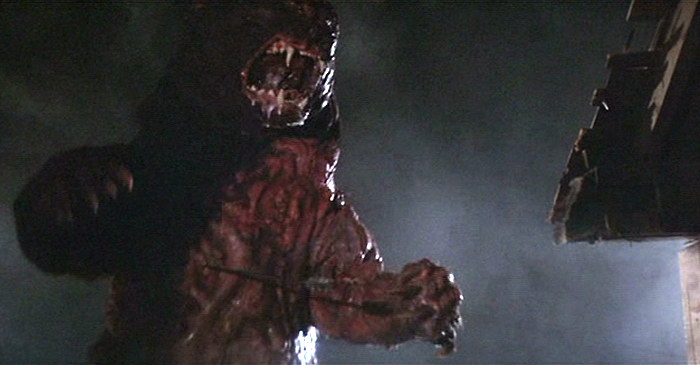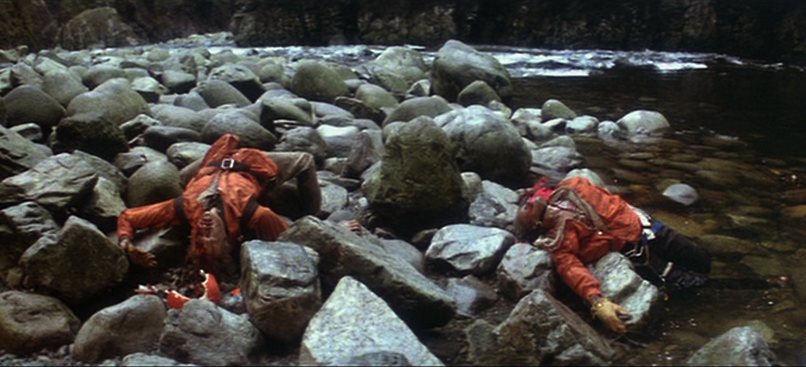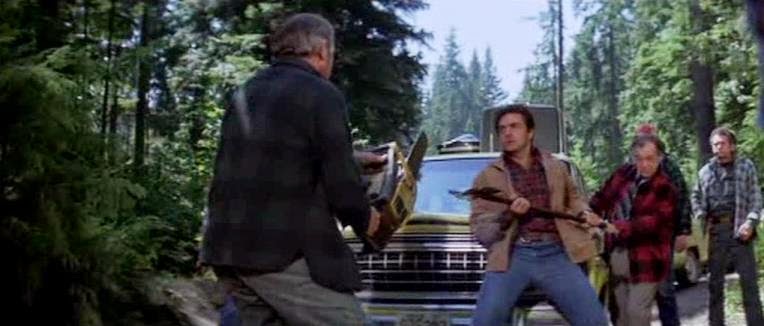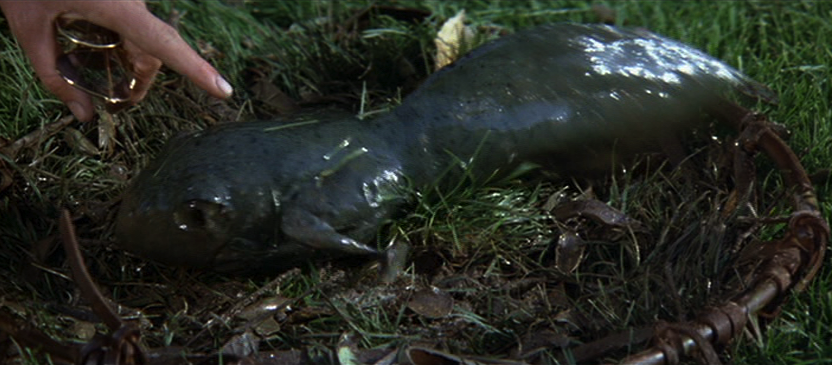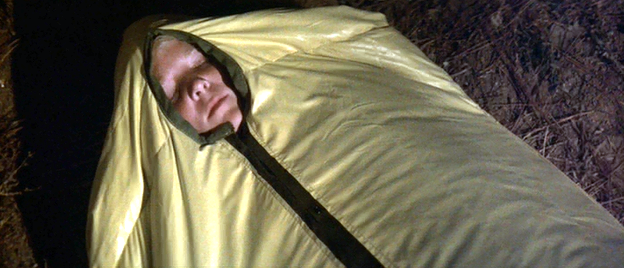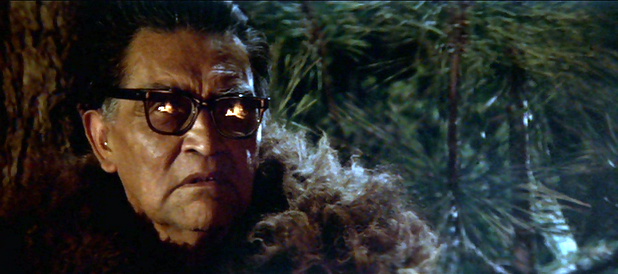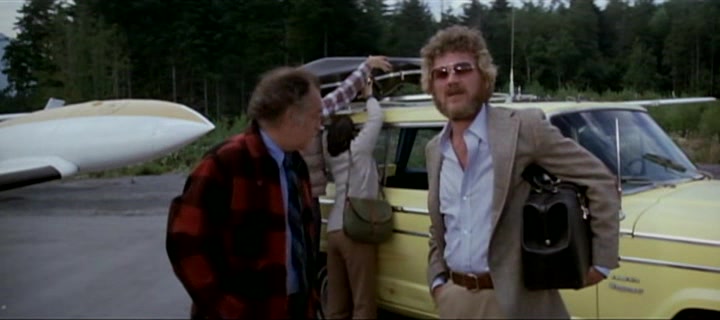
In northern California, most kids go trick-or-treating at abandoned gas stations.
This January, in support of the Toronto Rape Crisis Centre / Multicultural Women Against Rape, friends and family have raised over $1,000, which means I have to watch and write about thirty-one horror movies. I’ll watch (on average) one movie a night, many of them requested by donors, after which I’ll write some things about said movies on this website. Be forewarned that all such write-ups will contain spoilers! The most recent film is Halloween III: Season of the Witch, directed by Tommy Lee Wallace (Fright Night, Part 2, the television miniseries of Stephen King’s It). Halloween III: Season of the Witch is yet another of my donor-less viewings. I included it on the list because not only is it sometimes referred to as the best of the many Halloween movies, it is also sometimes referred to as one of the better horror movies, in general. We’ll see! Halloween III was rented from my other favourite video store – one with an exhaustive collection – Bay Street Video.
What happens:
Be forewarned if you don’t know what you’re getting yourself into, but Halloween III is that rarest of beasts: a Halloween without a Michael Myers. (Just so you don’t expect Michael Myers to show up in the final act.) What we have instead is horrific parable of corporate malfeasance, though much more premeditated than that seen in Prophecy. The film opens with some moody Carpenter-esque music (makes sense, since he wrote the music) over a slowly building LED display of a jack o’ lantern. Halloween III, this title sequence boldly proclaims, is a horror movie of the (early) digital age.
A lone man runs along a northern California highway late at night on October 23. Pursuing him at some distance is a shark-like car. The man, Harry Grimbridge (Al Berry) turns into a gas service station and attempts to enter the office or garage, but none of the buildings are unlocked. He crouches, stock-still, as the car slowly passes by the garage entrance. Thinking himself in the clear, he looks for somewhere else to hide, but the car reverses and pulls into the service station. Harry backs right into a well-manicured man in a suit, who promptly pushes him to the ground and starts to choke him. Harry pulls out the chain weight that’s keeping a car in place, and the car rolls right into his attacker, pinning him between two cars. Another besuited man exits the car and chases after Harry deeper into the station’s junkyard.

As much as I wanted it to be, that’s not Topher Grace.
An hour later, a gas station attendant half-watches a news report on how a block from Stonehenge has gone missing. An irritating commercial for Silver Shamrock novelties, advertising their Halloween masks, follows, complete with a bouncy “London Bridge” jingle. The attendant hears something outside in the storm. He goes to investigate and Harry leaps out at him, collapsing at the attendant’s feet. “They’re coming,” he moans. In his hand, he clutches a jack o’lantern mask.
Not far away, Dr. Dan Challis (Tom Atkins) visits his ex-wife, Linda (Nancy Kyes), and two kids. He’s brought them some Halloween gifts – two masks. The ungrateful kids, however, are disappointed. Their mother already bought them better masks from Silver Shamrock. Dr. Challis’s beeper goes off and he’s called in to work. Linda, noticing Challis is a bit tipsy, sneers, “drinking and doctoring: a great combination.” But Dan isn’t going to let a little thing like reduced motor skills stop him from fulfilling his hospital duties. The gas station attendant has brought in the exhausted and unresponsive Harry Grimbridge. But when a patient’s television plays the bouncy Silver Shamrock commercial, his eyes widen and he gasps, “they’re going to kill us.” Dan has the on-duty nurse, Agnes (Maidie Norman) bring Harry to a hospital bed.
The suited men, however, have been stalking the hospital from the outside. While Dr. Challis subjects Nurse Agnes to some old-fashioned sexual harassment – naturally, she’s charmed – the suited man sneaks into Harry’s hospital room, dons leather gloves, and digs his fingers into the prone Harry’s eye sockets. He twists and squeezes. Something gives and Harry Grimbridge dies. Nurse Agnes enters the room and asks the suited man what he’s doing. He exits without speaking, and the nurse, seeing Grimbridge dead, screams. Dr. Challis runs after the man in the suit, but before he can catch up to him in the parking lot, the man has entered his car. Then he douses himself in gasoline and sets himself and the car on fire. We can tell from his facial expression that Dr. Challis is mildly intrigued.
With the hospital murder-suicide, Dan calls his ex-wife to cancel his childcare responsibilities. The man’s daughter arrives to identify the body and is horrified by the state of her dad’s face. When she asks the police what happened, they assume the killer was a drug addict, high out of his mind. Dubious of the police’s claims, Dan later visits the coroner, the amiable Teddy (Wendy Wessberg). He asks Teddy to let him know if she finds any information on the immolated perp, but she only has ashes to go on at this point. Dan can’t imagine this murder was drug-related, noting how the killer seemed in total control and was dressed like a businessman. (Do you not realize how many drugs businessmen use, Dr. Challis?) Teddy agrees there must be something funny happening: “He had to be one strong businessman, I can tell you that. You don’t just pull someone’s skull apart without a little lower-arm strength, know what I mean?” (Do we ever.)
The good doctor drinks alone at a bar, which seems to play exclusively children’s programming – Dan can’t escape that Silver Shamrock commercial. Grimbridge’s daughter, Ellie (Stacey Nelkin), tracks Dan down and asks him about her dad’s final moments. Dan first lies, saying he talked about how he loved his daughter, but eventually he lets the truth slip about her dad’s bizarre last words and how he kept clutching that mask. Ellie takes Dan to her dad’s shop. Grimbridge ran a novelty shop in town, and the jack o’lantern mask was one of the Silver Shamrock masks he sold. Going through her dad’s extremely detailed records, Ellie is able to pinpoint when something seemed to go wrong – it was during a trip to Santa Mira, to the Silver Shamrock factory where they produce both those masks and those awful commercials. Soon, Dan is cancelling yet again on his ex-wife, and the duo are on a road trip to Santa Mira.

She was looking for her father’s murderer; what she found was true love.
Santa Mira, if you couldn’t tell by the name, is a largely Irish-American community centred around the Silver Shamrock factory, one of the largest producers of Halloween novelties and masks in the United States. Dan and Ellie’s arrival attracts a lot of attention – both from the locals in this cloistered town, and the ever-present security cameras. They decide to pose as a couple and check in to the local motel. Dan does a bit of detective work and notes that Harry, Ellie’s dad, checked into the motel on October 20. A hearse-like black car coasts by the motel parking lot and the hotel manger identifies it as the car of Mr. Cochran, owner of Silver Shamrock. Suddenly, the sleepy motel becomes a hive of activity, the Kupfer family – Buddy (Ralph Strait), Betty (Jadeen Barbor), and Little Buddy (Brad Schacter) – arrives in their RV, nearly driving over Dan. Another guest, a buyer unhappy with her Silver Shamrock mask order, also pulls into the parking lot.
Dan and Ellie realize they have to say overnight at the motel and Dan awkwardly asks where he should sleep – should he get another room? sleep in the car? Ellie cocks her eyebrow and asks, “Where do you want to sleep, Mr. Challis?” Thus begins their romantic relationship. At 6 p.m., factory loudspeakers announce the nightly curfew to the town, and the residents dutifully lock up their doors. Dan, however, brazenly flouts the curfew to pick up some booze. He runs into Starker (Jon Terry), a homeless man who asks for a swig from his bottle. Starker volunteers his thoughts on Cochran, whom he hates because he set up a massive factory in Santa Mira and brought in all his own workers. He doesn’t hire anyone local. Beyond that, Cochran has placed cameras all around the town, keeping tabs on every resident. Starker has heard rumours about the factory and says, cryptically, that this will be the last Halloween for the Silver Shamrock factory. He has plans for them.
That evening, Starker is accosted by two men in fine suits in his temporary junkyard home. He pleads forgiveness, but the men make Starker kneel, then one pulls Starker’s head off with his bare hands! Back at the motel, Ellie makes a friend with that buyer, Marge Guttman (Garn Stephens), who mistakes Ellie for another novelties purchaser. Marge has a store in San Francisco, and tells Ellie all about how easily the Silver Shamrock logo falls off the masks, thus ensuring the movie passes the Bechdel Test. Marge then returns to her room, knocking the medallion with the silver logo on it onto her carpet. Dan calls Teddy at her office and she says autopsy results on the murderer will be delayed; they had been doing an autopsy on part of the car by accident. The ashes they analyzed was all metal and plastic. After checking in with Teddy, Dan returns to his motel room and makes very awkward love with Ellie.
Just the other side of a thin motel-room wall, Marge sits in bed, reading. She spots the logo medallion on the floor and picks it up for closer inspection. With her reading glasses, she can see that the logo medallion is actually some kind of microchip. She takes a bobby pin and sticks it into the chip, causing a blue beam of light to blast her in the face. All that’s left of Marge’s mouth is a gory, bloody socket. Her bloodshot eyes stare down at her mess of a lower face in disbelief until a large locust crawls out of the mouth wound and up her forehead. (Just in case you were wondering when this movie was going to get gory.)
Dan and Ellie are woken from their post-coital slumber by a commotion outside. A number of men in white coats haul a stretcher into the back of an ambulance. Dan, being a doctor, leaves the room and asks what’s happening, though none of the “doctors” assembled will say much. Ellie recognizes that the body under the sheet must be that of her new friend Marge. Dan asks who is in charge of the patient, and the hotel manager answers that Mr. Cochran is. Conal Cochran (Dan O’Herlihy) arrives in his car and tries to allay Dan’s concerns. Marge, he says, will be taken to a medical facility at the factory. But Dan overhears Cochran talking to one of the “doctors” about a “misfire.” He’s about to ask a few more questions, but Ellie stops him, realizing they’re already attracting undue attention.
On the morning of October 30, Dan again calls in to Teddy, who says that the autopsy has become a total mystery: there’s nothing to indicate there ever was a body in the ashes they collected. Dan asks her to move on from the autopsy and instead find whatever she can about Conal Cochran. “This’ll cost you some serious dinners,” she flirts. (Everyone is totally charmed by Dr. Dan Challis.) Dan and Ellie visit the Silver Shamrock factory and inquire about Harry Grimbridge’s last order. The staff at the factory assure her that Grimbridge picked it up. The Kupfers arrive at the factory reception, too, and are warmly greeted by Mr. Cochran, dressed like a robber baron from the 1920s, complete with pocket watch and chain. Buddy Kupfer was the number one salesman of Silver Shamrock masks this past year, and as thanks, Cochran is going to give his family a tour of the mask factory. (Though how Kupfer is able to get away from his work during what must be his busiest time of year is never explained.) Kupfer insists they bring Ellie and Dan (whom he believes are called The Smiths) along on their Willy-Wonka-esque tour.

Conal Cochran, TCB.
The group tours the factory floor and even visits a bit of a Silver Shamrock museum, which delights Buddy. Cochran is something of an idol of his – ”He invented sticky toilet paper!” – but his son, Buddy Jr., just wants a jack o’lantern mask. Cochran makes sure Little Buddy gets a mask that has been through the “final process,” and puts it on the child’s face himself. Buddy Sr., intrigued, wants to know what this “final process” involves. Cochran is reticent, saying the final process is a trade secret, and involves volatile chemicals. Dan, growing bored with all the mask shop talk, notices an abundance of men in suits on the factory grounds – men who look a lot like the man who killed Ellie’s father. He brings this to Ellie’s attention and she soon notices her father’s car in a Silver Shamrock garage. She runs to the car, but her pathway is blocked by a number of those quiet men in suits.
Finally creeped out to their personal limits, Ellie and Dan make plans to leave town. Ellie begins to pack her things in the motel room and Dan goes to use the motel reception’s phone to alert the police. But none of the emergency or information numbers are accessible. Failing in his telephonic efforts, Dan returns to the motel room to find the door wide open and Ellie absent. He calls for her and looks outside to see a wall of men in suits. Dan locks the door and sneaks out the bathroom window while the suits try to forcefully enter through the front door. Dan runs through the night, evading any cars he sees on the road. One such car has the abducted Ellie confined in its backseat. Dan again tries to call for help – this time, from a pay phone – but is again blocked from reaching the outside world. He formulates a new plan to break into the Silver Shamrock factory.
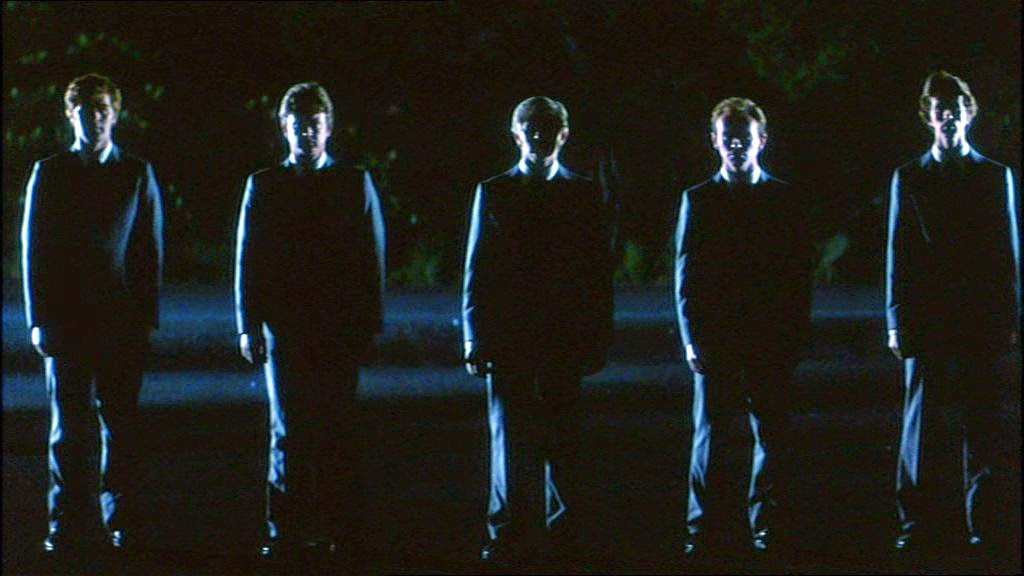
Unfortunately, they’re not about to embark on some dazzling choreography, a la New World Order.
Dan shimmies in through a window and sneaks through the factory, eventually reaching Cochran’s office. He opens the door to find an old woman knitting. Dan grabs the old woman by the shoulders and demands to know where Ellie is. When she fails to respond, he shakes her, sending her head toppling to the ground. The old knitting woman is a robot! But she looked so life-like … wait a minute. As if already reading the audience’s thoughts, one of the suits appears and grabs Dan by the head. Tom punches at the suited man desperately, eventually reaching into the man’s chest. Instead of pulling out a bunch of intestines (which would be really impressive), he pulls out a bunch of wires coated in (seemingly) Orangina. Half-melted orange concentrate similarly pours out the man’s mouth. He must be a robot, too!
Dan is quickly apprehended by two more of Cochran’s goons, who restrain him as the factory owner himself arrives. Cochran reveals that his workers are, in fact, robots. The insides, he says, were easier to fashion than the outsides. But it was just another form of mask-making in the end. Cochran takes Dan to the room where the “final processing” is done, and outlines his nefarious plans. In the centre of a massive control room, surrounded by computer terminals and robot lab technicians, is a big chunk of Stonehenge. Cochran’s drones are chipping off pieces of the mystical rock and using them to fashion microchips that are place the Silver Shamrock medallions affixed to every mask. Cochran instructs Dan to watch as he tests out his plan on his guinea pigs: the Kupfers.
The Kupfers are brought to a bunker (Test Room A) that’s made up like a suburban living room. Betty Kupfer begins to feel uncomfortable, but the television soon turns on and the repetitive Silver Shamrock commercial plays. The voiceover of the commercial instructs all children to put on their masks and watch the television screen, instructions that Little Buddy dutifully follows. He stares as an LED image of a jack o’lantern flashes before his eyes. Slowly, the mask becomes more organic, starts to rot, and the child collapses in front of the TV. From the pumpkin mask, dozens of insects crawl out, followed by a few large snakes. Betty Kupfer faints, while Big Buddy tries to escape the room. The snakes attack him and he collapses. Dr. Challis watches, dumbfounded. He realizes that children will be wearing these masks across the United States, and when they see that commercial on Halloween night, they, too, will die, their heads turned to mush, insects, and snakes (I guess).
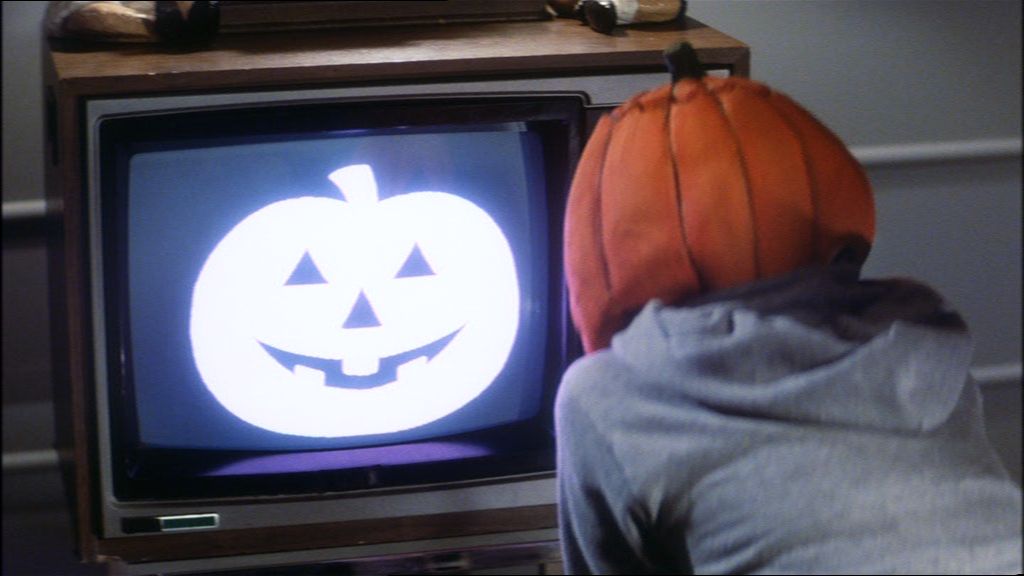
I can see why this show is so popular!
Teddy, meanwhile, tries to call Dan at the motel, but the motel number has been disconnected. A man in a suit, one office over, extracts a power drill from a drawer. Teddy absent-mindedly plays with some of the small car parts recovered from the murder-suicide and makes a startling realization: the part isn’t from the car, it’s from the murderer. At the moment of her epiphany, the suit grabs her and power-drills her skull to the ground. Back at the Silver Shamrock factory, Cochran has bound Dan Challis to a chair positioned in front of a television that plays the Halloween Horror-Thon (programming that features his commercials all night long). Dan demands to know why Cochran is doing this, and Cochran scoffs, “Do I need a reason? I do love a good joke, and this is the best ever. A joke on the children.” But pressed a bit further, he reveals himself to be a follower of witchcraft, taking Halloween back to its roots: the festival of Samhain, when the barriers between the real and the unreal fell. The places a Silver Shamrock skull mask on Dan’s face and wishes him a “Happy Halloween.”
After Cochran leaves, Dan desperately tries to escape the chair. He manages to kick in the television screen, then cuts himself free from his bonds with a handy pocketknife he had on him. (Cochran, search the captives! That’s villain rule number one!) He tosses the skull mask over the security camera and escapes the room. One of the robot lab technicians notices an obstruction over the camera in Challis’s room and alerts Cochran, who is busy on the phone schmoozing TV execs. The robots investigate the prisoner’s room, but Dan has escaped. He’s busy crawling through the ventilation ducts over the control room. Dan calls his ex from the factory floor in an attempt to convince her to throw out their kids’ masks. His ex-wife, pretty fed up with Dan’s nonsense by this point, refuses, saying Dan is either drunk or jealous.
With his children facing certain doom, Dan goes to free Ellie, but Cochran sees him rescue her. Dan and Ellie then sneak into the massive control room, hidden by a cart full of masks. Dan, who is clearly the most stealthy man in history, somehow manages to sneak behind all the robots and start up the final commercial within the room, then carries a bunch of Silver Shamrock medallions to the catwalk overhead, from which he tosses them like confetti. The combination of the subliminally messaged commercial with the microchip logos causes the robots to short-circuit and vomit up pea soup. Cochran realizes what’s happened, but is powerless to undo the actions Dan set in motion. The chunk of Stonehenge hums and a circle of power develops around the pile of logo medallions. A giant blue ray connects the two, driving right through Cochran, who dissipates into the ether.

A scene from Stargate: Origins?
Dan and Ellie leap into their car and speed away from the factory. Dan says that they have to alert people and make sure their children don’t watch the fateful commercial at 9 p.m. Ellie, however, reaches over and begins to claw at Dan’s face with super-strength. She’s not Ellie anymore; she’s one of Cochran’s creations! Dan pulls at the steering wheel and the car collides with a tree. He staggers out the car and walks over to the passenger side, where Ellie’s severed robot arm is still gripping the door handle. Ellie surprises Dan from behind, choking him with her one remaining arm. Dan reaches back for a tire iron and hits the robot Ellie until her head falls off. When he returns to the car, the disembodied arm tries to choke him, but he eventually breaks free. And then – once more, for good measure – Ellie’s headless, one-armed body makes a final Hail-Mary attack, but Dan easily bests it. What remains of Ellie collapses.
Hey, remember that gas station attendant at the beginning? Well, he’s back to his old tricks, watching television in the gas station office. A bloodied, haggard Dan rushes up to his gas station and demands to use the phone. While the Horror-Thon plays, Dan pleads with someone on the other end of the telephone – presumably a television programmer – to take the commercials off the air. As he does, three children wearing Silver Shamrock masks enter the gas station, trick-or-treating, and the attendant gives them candy. The Silver Shamrock commercial plays and the one child stares at the screen until a new screen – “Experiencing Technical Difficulties: Please Stand By” – appears. He changes the channel; it’s also on the fritz. But the third channel is still running the commercial. Dan shouts into the phone – “Stop it! Stop it!” – as the jack o’lantern begins to flash on the television screen.

Dr. Dan Challis is all about the do-not-call list.
Takeaway points:
- Fans of the Halloween movies may be inclined to ask, “Where’s Michael Myers?” After all, most Halloween movies feature the sociopathic masked killer. Halloween III is the odd film out. At the time of Halloween III, producer John Carpenter planned to make a new Halloween movie each year, each with a totally different Halloween-themed tale. The series would be like an anthology of Halloween-set stories. But Halloween III tanked at the box office and the series returned by giving the people what they wanted: more Michael Myers!
- As ham-fisted as it may be, Halloween III is undoubtedly a strong corporate critique and a cautionary tale about merchandising to kids. After all, kids who watch too many commercials in this film literally die. A pretty pointed criticism, I’d say. Though it would be more pointed if the business owner had a believable motive – like improving company shares, rather than taking innate pleasure children’s deaths and having a steadfast commitment to the Irish witch lifestyle. Halloween III‘s willingness to murder children like Little Buddy, along with the real downer of the ending, demonstrates how damaging the filmmakers think children’s marketing really is. (That said, Carpenter has always been willing to kill children in his movies.) Though the film wasn’t directed by John Carpenter, you can easily view Halloween III as a kind of proto-They Live, which took this idea of subliminal corporate messaging and ran with it.
- Perhaps the quaintest thing is how Halloween III uses the factory’s private surveillance – cameras all over town – as a clear indication of its evil nature. In 1982, the sight of these hidden cameras would have tweaked any viewer to some business wrongdoing going down, but I feel that privately operated security cameras are so ubiquitous now, the depiction of the cameras as ominous is just adorable. In 2016, we’re alarmed when we’re not under surveillance.
- One thing Halloween III does share with the original is the intensely moody electronic score, provided by John Carpenter himself. The music in Halloween III is everything. The score gives the scenes any suspense and terror they may possess and shoulders the majority of the work building the spooky atmosphere in Santa Mira.
- I can’t be the only one who watched Halloween III and saw the clear parallels between Conal Cochran’s mask-based murder plot and The Riddler’s similarly ludicrous scheme to beam television directly into viewers’ brains in Batman Forever. Rest assured, Halloween III is the superior third film of the two series.
Truly terrifying or truly terrible?: Somebody lied to me when they claimed this was the best Halloween movie. Halloween III is, for sure, a movie of note, but one cannot place it in the realm of the terrifying. There is some very impressive gore on display and a novel take on the Invasion of the Body Snatchers theme, but it’s also, at times, quite laughable.
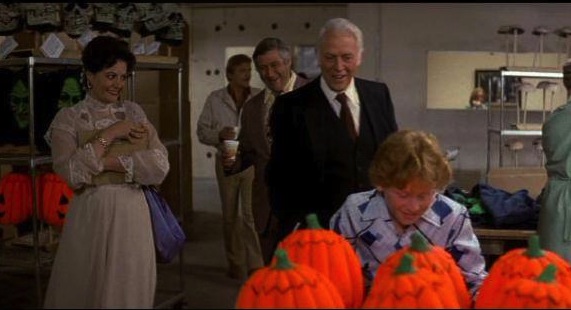
Betty Kupfer, apparently in June Carter Cash cosplay, for the factory tour.
Best outfit: My eye for labels isn’t great, but I’m pretty sure the moustachioed Dr. Dan Challis is wearing a Members’ Only jacket for the majority of the film. But if you want to talk bold fashion choices, I have two words for you: Betty Kupfer.
Best line: “We had a time getting it here. You wouldn’t believe how we did it.” – Conal Cochran, referring to the clandestine transport of a rock from Stonehenge to northern California. And no, we wouldn’t.
Best kill: It’s unclear whether Marge Guttman actually dies from blasting herself in the face with a Stonehenge ray, but the result is grue-some to the max.
Unexpected cameo: The star of the film, Tom Atkins, is forever remembered by horror fans as either Ray Cameron, the no-nonsense cop from Night of the Creeps or Frank McCrae from Maniac Cop. There’s also a stellar voice-over cameo by Jamie Lee Curtis, the star of the original Halloween, who provides the voice of the operator when Dan Challis tries to call out of Santa Mira.
Unexpected lesson(s) learned: If you find a television commercial to be annoying, it’s most likely because the company responsible has devised a plot to make your children’s heads explode into a pile of bugs and snakes (or something).
Most suitable band name derived from the movie: Silver Shamrock
Next up: Re-Animator (1985).
